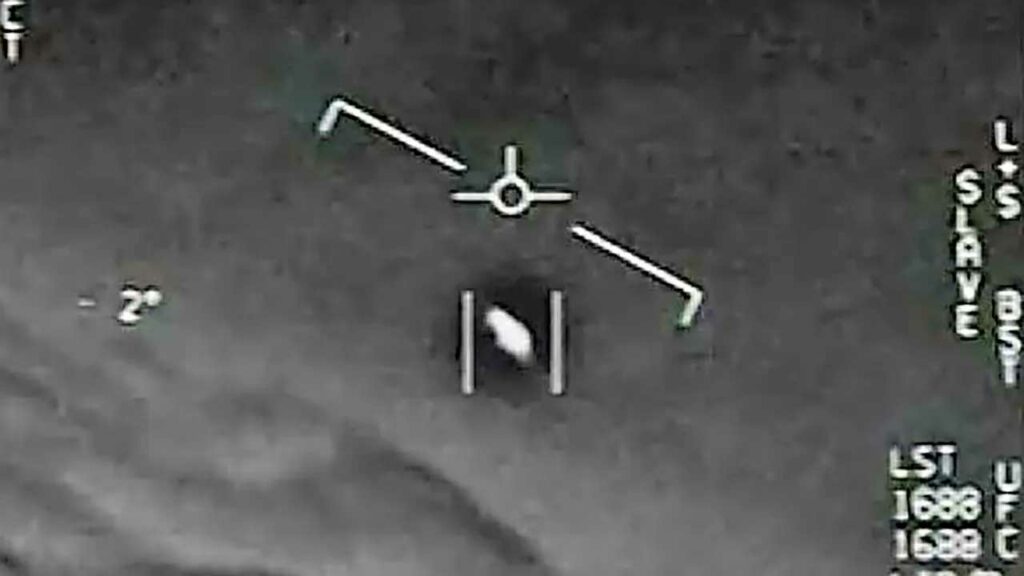
An in-depth look at the Pentagon’s Advanced Aerospace Threat Identification Program (AATIP) and its technical and military implications.
The Advanced Aerospace Threat Identification Program (AATIP) is a secret Pentagon program launched in 2007 to study unidentified aerospace phenomena. With a budget of $22 million** (around €19 million**), its aim is to analyze technical and scientific data linked to unexplained sightings of flying machines. The program officially ended in 2012, but reports suggest that its activities have continued informally. AATIP raises crucial questions about national security, technological advances and the need for a rigorous scientific approach to understanding these phenomena.
AATIP program origins and funding
The AATIP program was initiated in 2007 by Nevada Senator Harry Reid, then Majority Leader of the U.S. Senate. Sensitized by reports of unexplained aerial sightings, Reid managed to allocate a budget of $22 million (about 19 million euros) over a five-year period. This funding was hidden in the annual Department of Defense budget, making the program largely unknown to the public and many officials.
The choice of funding is explained by the need to protect national security. Unidentified flying objects (UFOs) had been reported near sensitive military bases, raising concerns about possible foreign surveillance or unknown technologies. The budget was mainly used to collect and analyze data, including radar recordings, pilot testimonies and suspected material samples.

Scientific and technological methodology
The Advanced Aerospace Threat Identification Program (AATIP) established a comprehensive methodology for investigating unidentified aerospace phenomena. This approach combined advanced scientific techniques and state-of-the-art technologies to collect, analyze and interpret data related to observations.
multi-disciplinary teams
The program brought together physicists, aerospace engineers, imaging experts, intelligence analysts and psychological specialists. This multidisciplinary team made it possible to approach the phenomena from different angles, taking into account physical, technological and human aspects.
Multiple data collection
AATIP researchers exploited a variety of data sources:
- Radar data: Military and civilian radar records were analyzed to detect objects moving at unusual speeds or trajectories.
- Infrared video: Infrared sensors were used to detect thermal signatures of objects, revealing information about their propulsion and energy.
- Eyewitness reports: Reports from pilots, naval personnel and other qualified witnesses were collected and assessed for reliability and consistency.
- Audio recordings: Communications between pilots and air traffic controllers were reviewed to contextualize events.
- Material samples: In rare cases, materials presumed to have come from the objects were recovered for laboratory analysis.
Advanced analysis techniques
A central element of the methodology was the application of rigorous scientific techniques to ensure the objectivity of the findings.
- Spectroscopy: By analyzing the spectra of light emitted or reflected by the objects, scientists could identify chemical and energy signatures, providing clues to material composition and potential propulsion methods.
- Kinematic analysis: Object trajectories were modeled to calculate parameters such as acceleration, velocity and the forces involved. Some objects exhibited accelerations in excess of *100 g*, well beyond human tolerance and the capabilities of known aircraft.
- Image and signal processing: Video and images were processed to improve clarity, eliminate noise and extract details not visible to the naked eye. State-of-the-art algorithms were used to detect patterns and anomalies.
- Computer modeling: Simulations were carried out to test different hypotheses about the nature of the objects, including aerodynamic and electromagnetic models.
Bias assessment and validation
Aware of potential biases, the researchers implemented protocols to validate the data:
- Multi-sensor corroboration: An observation ideally needed to be confirmed by several independent sensors (radar, infrared, visual) to be considered credible.
- Statistical analysis: Data were compiled over several incidents to identify trends or regularities, reducing the impact of isolated anomalies.
- Peer review: Preliminary findings were submitted to external experts for independent assessment.
Specific case studies
For example, during the USS Princeton incident in 2004, objects were detected descending from altitudes of 20,000 meters to just above the ocean surface in a matter of seconds. AN/SPY-1 radar data were cross-referenced with infrared recordings from F/A-18 Super Hornet aircraft deployed to investigate. No conventional explanation could be given for these performances.
Collaboration with other agencies
AATIP also collaborated with entities such as NASA, the Federal Aviation Administration (FAA) and national laboratories to access additional resources and share relevant data. This inter-agency cooperation has broadened the scope of knowledge and enabled the application of diverse expertise.
Skeptical and open approach
Although the program was open to all possibilities, including unknown technologies, it maintained a skeptical approach. Every exotic hypothesis had to be supported by solid evidence. Conventional explanations, such as meteorological phenomena, classified military prototypes or instrumental errors, were systematically considered and discarded only in the event of evidence to the contrary.
Staff training and protocols
To improve the quality of data collected, AATIP developed training programs for military personnel on how to recognize, document and report unusual phenomena. Standardized protocols have been established to ensure consistent and useful data collection for scientific analysis.
Discoveries and data collected
In the course of its operation, AATIP has accumulated a significant amount of data on Unidentified Aerial Phenomena (UAP). Over 200 detailed reports have been compiled, mainly from highly qualified military personnel, such as fighter pilots, radar operators and naval officers. These reports were subjected to rigorous analysis to identify recurring patterns and understand the nature of these phenomena.
Notable incidents
Among the most notable cases was the USS Nimitz incident in November 2004. Pilots from the VFA-41 fighter squadron were dispatched to intercept an object spotted by the USS Princeton missile cruiser off the Californian coast. The object, nicknamed the “Tic Tac ” because of its elongated, white shape, was observed performing maneuvers that defied the known laws of physics. It could go from an altitude of 20,000 meters to near the surface of the ocean in a matter of seconds, with no sign of conventional propulsion or wings.
Pilots reported that the object seemed to anticipate their movements, moving in direct response to their interception attempts. On-board sensors, including the AN/ASQ-228 Advanced Targeting Forward-Looking Infrared (ATFLIR) systems, captured video of the object executing right-angle turns and accelerating to speeds in excess of 7,000 km/h. No heat signatures corresponding to known propulsion were detected, adding to the mystery of its energy source.
In 2015, pilots from the VFA-11 “Red Rippers ” squadron operating from the USS Theodore Roosevelt also encountered similar objects off the east coast of the USA. Videos dubbed “Gimbal ‘ and ’GoFast ” show objects moving at high speed against winds of over 200 km/h. The objects appeared to be capable of hovering without visible means of support, and rotated on their central axis.
Advanced technological features
The data collected revealed several features common to these phenomena:
- No visible means of propulsion: No identifiable reactor, rotor or propulsion system was observed, either visually or via infrared sensors.
- Instantaneous accelerations : Objects could go from immobility to hypersonic speeds in an extremely short time, generating acceleration forces far beyond human resistance and known materials.
- High-performance maneuvers: Ability to make sharp right-angle turns without loss of speed or indications of inertia, defying the principles of classical dynamics.
- Trans-medium capability: Some objects have been observed moving between air and water with no apparent impact on performance or structural damage, suggesting resistance to extreme pressure and cavitation.
- Absence of thermal signature: Despite high speeds, no excessive heat was detected, which is unusual given the expected aerodynamic friction.
Data analysis
The radar recordings were crucial in corroborating the visual observations. Systems such as the SPY-1 of the Aegis combat system provided precise data on object speed, altitude and trajectories. The absence of transponders and responses to queries from the Friend or Foe Identification System (IFF) ruled out the possibility of conventional or known aircraft.
Pilot testimonies were collected and compared to assess the consistency of the descriptions. Strict protocols were followed to minimize bias and ensure reliable reporting. Pilots described feelings of “physics defiance ”, expressing amazement at unprecedented aeronautical capabilities.
Material samples and physical analysis
In some cases, material samples associated with these phenomena have been recovered. Extensive scientific analysis was carried out to determine their composition and properties. Some materials showed unusual atomic or isotopic structures, not corresponding to known alloys or composites. For example, reports mention materials with layers of layered metals on a nanometric scale, offering exceptional mechanical and electromagnetic properties.
Databases and modeling
The information was centralized in a specialized database, enabling statistical analysis and modeling of the phenomena observed. Machine learning algorithms were used to detect recurring patterns, geographical or temporal correlations, and to anticipate potential future occurrences.
The data was also used to feed physical and computational models, exploring advanced theories such as directed-energy propulsion systems, ambient-temperature superconductivity technologies or large-scale quantum effects. Although speculative, this research aims to explain the observed capabilities and assess their theoretical feasibility.
International collaborations
AATIP has exchanged information with international partners. Similar incidents have been reported by military forces in allied countries, reinforcing the idea that these phenomena are global and not limited to US airspace. Secure communication channels have been established to share sensitive data while maintaining the required confidentiality.
National security implications
The AATIP discoveries have raised crucial questions about the vulnerability of air and sea space. The inability to identify these objects and understand their potential intentions represents a challenge for defense strategies. Sightings near sensitive military sites heighten concerns about possible foreign surveillance or the existence of unconventional technologies developed by state or non-state actors.

Military and national security implications
AATIP discoveries have major implications for national security. If these phenomena are the result of advanced foreign technologies, this represents a strategic risk for the United States. The fact that these objects can operate near sensitive military sites without prior detection raises concerns about current defense capabilities.
In addition, the inability to identify the origin of these objects poses intelligence and counter-intelligence challenges. The military needs to consider updating detection and tracking systems, as well as developing protocols to manage such encounters.
Scientific and technological implications
The performances observed by AATIP stimulate questions about the laws of physics as we understand them. The maneuvers and speeds recorded defy the known limits of aerospace technology and modern physics, particularly with regard to acceleration, gravity and air resistance.
These anomalies offer an opportunity for the scientific community to explore new areas of research, such as advanced propulsion, materials resistant to extreme stress and theoretical physics beyond the Standard Model.
Economic and industrial consequences
If the technologies observed can be understood and reproduced, this could lead to an industrial revolution. Potential applications include supersonic transport, advanced energy systems and new methods of communication. Investment in research could stimulate innovation and create new markets.
However, the development of such technologies requires significant funding and collaboration between the public and private sectors. The defense, aerospace and energy industries could be key players in this transformation.
Transparency and public communication
The revelation of AATIP’s existence in 2017 sparked a debate on government transparency. Citizens and scientists alike are demanding more information to independently assess the data. The Pentagon has since created the Unidentified Aerial Phenomena Task Force (UAPTF) to pursue this research more openly.
Transparent communication is essential to inform the public, avoid unfounded speculation and encourage a collective scientific approach. It could also strengthen trust between government and citizens on issues of national security.
The Pentagon’s AATIP program represents a significant initiative to understand unexplained aerospace phenomena. The technical, military, economic and scientific implications are vast. A methodical, transparent and collaborative approach is essential to make progress in this complex investigation. Potential discoveries could not only enhance national security, but also pave the way for major technological advances for mankind.
War Wings Daily is an independant magazine.